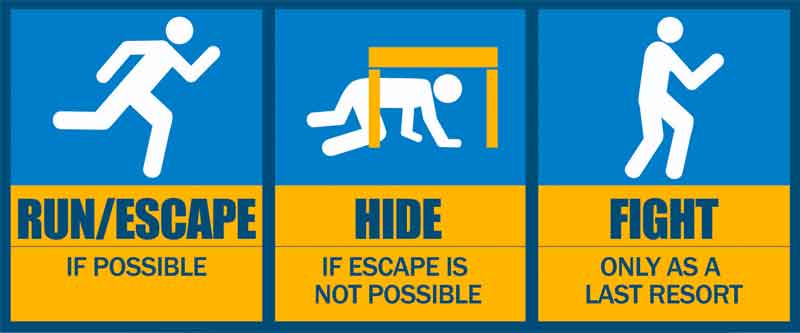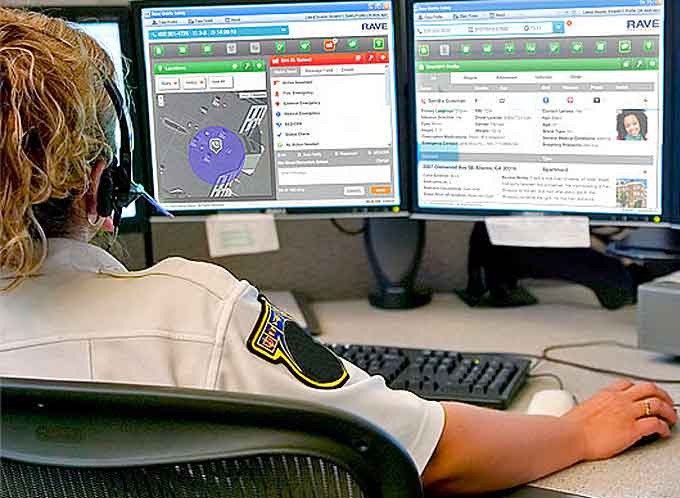
By Stefanie Valentic, EHS Today
On April 3, 2018, 38-year-old Nasim Najafi Aghdam entered YouTube’s headquarters with a semi-automatic pistol and began shooting company employees.
The act of workplace violence at the video sharing company’s San Bruno, Calif., office was only one of many incidents that have caused widespread media attention and discussions about what companies can do to protect their workers from active shooting situations.
(Nasim Najafi Aghdam allegedly opened fire at YouTube’s California headquarters, injuring three people before killing herself, according to police. Courtesy of ABC News and YouTube. Posted on Apr 4, 2018.)
“Given the current landscape of the workforce, a company’s ability to focus on an active shooter or workplace violence incident is absolutely paramount,” says Juliette Kayyem, CEO of Zemcar.

“Moving forward, leading organizations need to ensure the safety of employees by bringing these policies into the workplace and putting them into practice, much like how fire drills are already a regular event for employees.”
While workplace violence statistics often are underreported, the numbers that are available only demonstrate that it is far more prevalent.
The most recent data available estimates that more than 2 million people are victims of a workplace violence incident each year.
The FBI states that 80 percent of all active shooting incidents happen on the job. However, many employers still remain unprepared.
EHS professionals and employers can create a secure workplace through training workers to recognize the signs of a disgruntled employee as well as having a solid emergency response plan in place should an act of violence occur.
(Learn More. Impact of Workplace Violence, Types of Workplace Violence, Risk Factors, Warning Signs, Preventing/Reducing Workplace Violence, Response Actions. Courtesy of osha safety training and YouTube. Posted on Feb 24, 2015.)
Causes
The most common types of workplace violence vary by industry, but can be broken down into four parts (See “Types of Workplace Violence”).
The FBI provides detailed information about the different occurrences on its website and published resources.
The U.S. workforce spends on average about one-third of their life in the workplace, according to numerous studies. So, knowing your coworkers and surroundings is crucial to preventing a workplace violence incident.

“Employees typically know when something is ‘off’,” says Vic Merjanian, founder and CEO of Titan HST.
“Common warning signs in individuals are increased aggression, harassment towards customers or employees, concealment of a weapon and interpersonal conduct that doesn’t fit the setting.”
It is also important to be wary of biases an individual may possess and to ensure that the perceived threat is based on objective criteria, he adds.
Workplace safety is ever evolving, and communicating threats as well active situations is key to sending workers home safe every day.
(See the impact of Rave Mobile Safety technology in 60 Seconds, and find out how Rave’s revolutionary safety technology can help keep your people safe. Courtesy of Rave Mobile Safety and YouTube. Posted on Jan 31, 2017.)
Communication
A survey conducted by Rave Mobile Safety shows the need for effective communication in workplace violence incidents.
More than half of Millennial respondents (53%) said they were unaware of their company’s emergency plans or that their employer had no plan in place.
Only 34% of respondents aged 45 and older indicated the same.
In addition, the survey discovered that only half of those 45 and older were “very likely” to report an issue when it comes to worker safety, and just 8% of Millennials surveyed said the same.
Facilitating the right communications methods is an essential step.
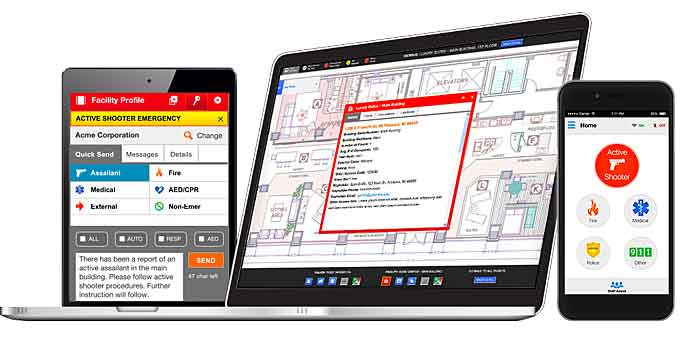
“Initiating quick, direct and informative communication is essential,” Merjanian says.
“Being able to share what the threat looks like, where the threat is located and any other pertinent details is always helpful to emergency responders.”
When it comes to technology, employers should ensure workers have proper cellular access and Wi-Fi connection to facilitate calls should an emergency occur.
Emergency applications can be downloaded on smartphones to communicate more directly across the employee network, notify emergency responders and download lifesaving resources such as CPR and first aid instructions.

When it comes to protecting both the workplace and employees, installing security cameras in vulnerable building access points such as loading docks, shipping and receiving entrances, parking garages, or main entrances can deter criminal activity, says Amy Harper, senior director of workplace strategy and consulting operations at the National Safety Council (NSC).
Harper adds that employers have recognized the need to address workplace violence and set up policies to address this through employee training, conducting mock training exercises, adopting a zero-tolerance policy toward workplace violence and creating an emergency action plan.
Making a Plan
Emergency response plans should be clear and direct with how workers should react or handle a situation.
These plans should include proper procedures for assessing, documenting and acting on potential threats, Merjanian says.
“Unfortunately, we find that many workplaces do not have any plans in place, or have plans that are very outdated and do not address the threats that employees may encounter in today’s workplace,” he says.
When it comes to documentation, companies should have written protocols for terminations and demotions/job changes of workers that identify potential security and employee safety concerns in order to mitigate those, Harper says.
(Learn More. The stats continue to be shocking year after year regarding the very real hazard of workplace violence. As a result, we are seeing OSHA actively evaluate if employers have a written plan in place. Courtesy of Summit Safety Group and YouTube. Posted on Apr 2, 2017.)
Security badges as well as badge-based permissions should be made available to ensure only approved workers are able to access the facility or any restricted areas.
“Contractor management programs help account for any non-employee presence onsite and having protocols for contractors to “check in” upon arrival ensures they are expected and have approval to provide services,” Harper says.
When a threat or incident occurs, a structured response needs to take place in order to keep workers safe.
“Once a threat is identified, the question becomes — do we contain the threat, assuming we can, or do we advise employees and customers to initiate a lockdown?” Merjanian says.
The first step workers should take is to immediately contact security or law enforcement.
(In seconds, Rave Panic Button clearly communicates an emergency to 9-1-1, faculty, staff, and first responders, law enforcement and emergency medical professionals. Courtesy of Rave Mobile Safety and YouTube. Posted on Apr 13, 2017.)
Then, employees can move coworkers, themselves, and any potential customers in to a safer place if they are able to, he says.
“It is generally not advisable to approach the threat,” Merjanian says.
“If you do see a weapon and decide the only option is to approach the threat, the employee must make sure to commit to their actions and not hesitate.”
In an active situation, the best advice is to stay calm and exercise one of three options: run, hide or fight, Harper says (See “Run, Hide, Fight”).
“Some people commit violence because of revenge, robbery or ideology – with or without a component of mental illness,” Harper says.
“There is no way of knowing when an attack is imminent. So it’s important to be vigilant and alert, and to have prepared ahead of time, being sure to train employees on appropriate responses.”
(There are often many places you could hide in your office, but this but video will tell you what to look for. Learn from David Katz, a former senior special agent with the Drug Enforcement Administration, has provided training to police units and tactical teams around the world, including the Israeli General Security Service, the New York City Police Department Emergency Services Unit and the Marine detail assigned to HMX-1, the president’s official helicopter. Courtesy of the New York Post and YouTube. Posted on Jul 5, 2016.)
Types of Workplace Violence
 TYPE 1: Violent acts by criminals who have no other connection with the workplace other than to enter to commit robbery or another crime.
TYPE 1: Violent acts by criminals who have no other connection with the workplace other than to enter to commit robbery or another crime.
Type 1 violence by criminals otherwise unconnected to the workplace accounts for the vast majority—nearly 80% —of workplace homicides.
In these incidents, the motive is usually theft, and in a great many cases, the criminal is carrying a gun or other weapon, increasing the likelihood that the victim will be killed or seriously wounded.
This type of violence falls heavily in industries where workers’ jobs make them vulnerable: taxi drivers such as late-night retail or gas station clerks, and others who are on duty at night, who work in isolation.
TYPE 2: Violence directed at employees by customers, clients, patients, students, inmates, or any others for whom an organization provides services.
Type 2 cases typically involve assaults on a worker by a customer, patient or someone else receiving a service.
In general, the violent acts occur as workers are performing their normal tasks.
In some occupations, dealing with dangerous people is inherent in the job, as in the case of a police officer, correctional officer, security guard, or mental health worker.
For other occupations, violent reactions by a customer or client are unpredictable, triggered by an argument, anger at the quality of service or denial of service, delays, or some other precipitating event.
(The suspect in a deadly shooting at a newspaper office in Maryland damaged his fingertips so they couldn’t be used to identify him, according to a law enforcement source. Authorities said five people were killed in the shooting. Courtesy of CBS News and YouTube. Posted on Jun 28, 2018.)
TYPE 3: Violence against coworkers, supervisors, or managers by a present or former worker.
TYPE 4: Violence committed in the workplace by someone who doesn’t work there, but has a personal relationship with an employee—an abusive spouse or domestic partner.
(22-year-old Jasmine Wollack was shot and killed by her boyfriend. Courtesy of News 4 Tucson KVOA-TV and YouTube. Posted on Feb 2, 2018.)
Type 3 and Type 4 violence comprise of incidents involving violence by past or present employees and acts committed by domestic abusers or arising from other personal relationships that follow a worker into their place of employment.
Violence in these categories is no less or more dangerous or damaging than any other violent act.
When the violence comes from a worker or someone close to that worker, there is a much greater chance that some warning sign will have reached the employer in the form of observable behavior.
Source: U.S. Department of Justice, Federal Bureau of Investigation
Run, Hide, Fight
RUN—If there is an accessible escape path, attempt to evacuate the premises.
Be sure to:
• Have an escape route and plan in mind
• Evacuate regardless of whether others agree to follow
• Leave your belongings behind
• Help others escape, if possible
• Prevent individuals from entering an area where the active shooter may be
• Keep your hands visible
• Follow the instructions of any police officers
• Do not attempt to move wounded people
• Call 911 when you are safe

HIDE—If evacuation is not possible, find a place to hide where the active shooter is less likely to find you.
Your hiding place should:
• Be out of the active shooter’s view
• Provide protection if shots are fired in your direction (i.e., an office with a closed and locked door)
• Not trap you or restrict your options for movement
To prevent an active shooter from entering your hiding place:
• Lock the door
• Blockade the door with heavy furniture is nearby:
• Silence your cell phone and/or pager
• Turn off any source of noise (i.e., radios, televisions)
• Hide behind large items (i.e., cabinets, desks)
• Remain quiet
If evacuation and hiding out are not possible:
• Remain calm
• Dial 911, if possible, to alert police to the active shooter’s location
• If you cannot speak, leave the line open and allow the dispatcher to listen
FIGHT—As a last resort, and only when your life is in imminent danger, attempt to disrupt and/or incapacitate the active shooter by:
• Acting as aggressively as possible against him/her
• Throwing items and improvising weapons
• Yelling
• Committing to your actions
(Learn More. Courtesy of California State University and YouTube. Posted on Feb 15, 2018.)
Source: National Safety Council
Original post http://www.ehstoday.com/safety/taking-action-against-acts-workplace-violence
Rave Mobile Safety
Rave Mobile Safety (Rave), a trusted partner for safety software protecting millions of individuals, and Two-Time Award Winner of the 2017 ‘ASTORS’ Homeland Security Awards Program, is positioned to continue to be a leader in the security space for the foreseeable future.
 As violence in schools and the workplace continue to dominate headlines, implementing safety-enhancing technologies is more important than ever.
As violence in schools and the workplace continue to dominate headlines, implementing safety-enhancing technologies is more important than ever.
With these current threats to public safety, Rave has continued to partner with a variety of industries, including state and local government, higher education, K-12, healthcare and more, to enhance their security.
Rave Panic Button
One Button Push to Improve Response Times

In 2017, Rave launched new customer implementations that led to increased safety across the country in a number of industries.
Rave solutions helped shape organizations safety procedures from higher education settings to major public events.
Rave Guardian
Two-Way Critical Communications and Personal Safety App
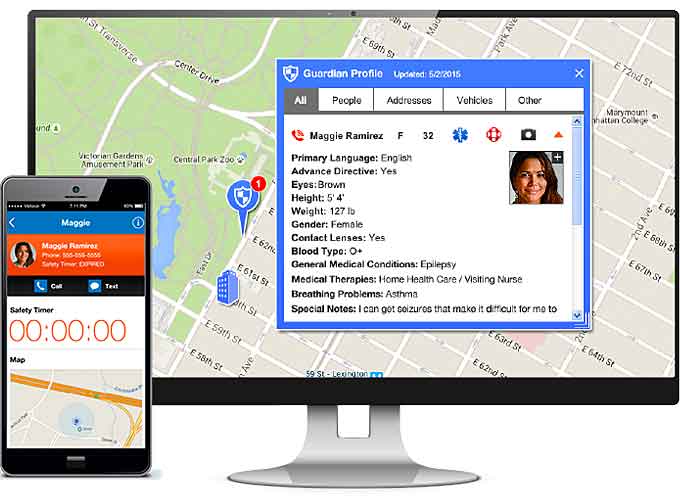
Preventing Student Self-Harm with Technology
The University of Cincinnati sought to improve safety for over 43,000 students, faculty and staff across their 200+ acre campus last year with the implementation of Rave Guardian, a two-way critical communications and personal safety application designed to connect users directly to the university’s security resources.
(Learn More about Rave Guardian. Students and faculty at Texas A&M University-Kingsville, one of many universities, are starting off the school year knowing they have an extra safety took available to them – an app called: Rave Guardian. Courtesy of Rave Mobile Safety and YouTube. Posted on Aug 23, 2016.)

“Safety is a top priority for our university, and we’ve already seen the benefits of Rave’s technology working firsthand as we were able to prevent a student from causing self-harm,” said Edward Dadosky, EMA director at the University of Cincinnati.
“Through this technology, our students are able to send tips anonymously to notify the appropriate personnel should they be concerned about the well-being of a friend or classmate.”
Rave 911 Suite
Powerful Data and Communication Tools to Save Time and Lives
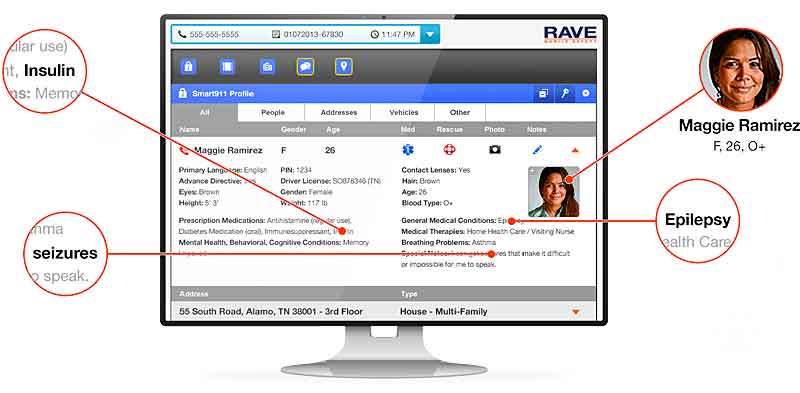
Protecting 500,000 at the Kentucky Derby and Beyond
After the City of Louisville selected Rave to power its LENS (Louisville Emergency Notification System) Alert solution in August 2015, the city upgraded to the Rave 911 Suite in 2017.
This 9-1-1 technology provides first responders with powerful capabilities for handling, dispatching and responding to emergency calls more efficiently and effectively.
(When the 911 call rang into Tuscola County Central Dispatch, all dispatcher Amanda Berlin heard was arguing and screaming then the line went dead. With the help of the Smart911, which allows victims to text 911, dispatch can identify an exact address and get someone there immediately. Courtesy of Rave Mobile Safety and YouTube. Posted on May 18, 2016.)

“The flexibility of Rave’s solution gave us peace of mind when more than half a million individuals came into the city for the Kentucky Derby,” said Mitchell Burmeister, public information officer at Louisville Metro Emergency Services.
“The upgrade to the Rave 911 Suite will only further increase the safety of our residents even when we see a boost in visitors during events throughout the area.”
Rave Mobile Wins Big in the 2017 ‘ASTORS’ Homeland Security Awards Program
-
Rave Mobile Safety
- Platinum ‘ASTORS’ Award Winner
- Rave Mobile Safety Alert
- Best IP Mass Notification System

-
Rave Mobile Safety
- Gold ‘ASTORS’ Award Winner
- Rave Panic Button
- Best Emergency Mobile Technology
AST focuses on Homeland Security and Public Safety Breaking News, the Newest Initiatives and Hottest Technologies in Physical & IT Security, essential to meeting today’s growing security challenges.
The Annual ‘ASTORS’ Homeland Security Awards Program, is organized to recognize the most distinguished vendors of Physical, IT, Port Security, Law Enforcement, Border Security, First Responders, (Fire, EMT, Military, Support Services Vets, SBA, Medical Tech) as well as the Federal, State, County and Municipal Government Agencies – to acknowledge their outstanding efforts to ‘Keep our Nation Secure, One City at a Time.’
To Learn More about the ‘ASTORS’ Homeland Security Awards Program, see 2017 ‘ASTORS’ Homeland Security Award Winners Honored at ISC East.

Over 100 distinguished guests from National, State and Local Governments, and Industry Leading Corporate Executives from companies allied to Government, gathered from across North America and the Middle East to be honored from disciplines across the Security Industry in their respective fields which included representatives from:
- The Department of Homeland Security
- U.S. Customs and Border Protesction
- The Department of Justice
- The Security Exchange Commission
- State and Municipal Law Enforcement Agencies
- The Royal Canadian Mounted Police
- Leaders in Private Security
Recognized for their Innovative Training and Education Programs, Outstanding Product Development Achievements and Exciting New Technologies to address the growing Homeland Security Threats our Nation is facing.
Nominations are now being accepted for the 2018 ‘ASTORS’ Homeland Security Awards at https://americansecuritytoday.com/ast-awards/.
American Security Today will be holding the 2018 ‘ASTORS’ Awards Presentation Luncheon to honor Nominees, Finalists and Winners on November 14, 2018 at ISC East 2018 in New York City.
To learn More about Rave Mobile Safety’s wide range of product offerings, please visit https://www.ravemobilesafety.com/.
For ‘ASTORS’ Sponsorship Opportunities and More Information on the AST 2018 ‘ASTORS’ Homeland Security Awards Program, please contact Michael Madsen, AST Publisher at: mmadsen@americansecuritytoday.com or call 732.233.8119 (mobile) or 646-450-6027 (office)
Learn More…
Active Shooters: An Evolving Threat Requires an Updated Solution













